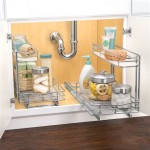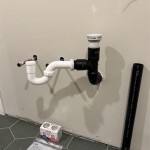Bathroom Sink Leaking From Handle: Causes and Solutions
A leaky bathroom sink is a common household problem, often originating from the handle. When water drips or trickles from the faucet even when it's turned off, it can be a source of frustration and waste. Fortunately, identifying the cause of the leak is usually straightforward, and fixing it often involves simple repairs. This article will explore the common causes of bathroom sink leaks from the handle, provide a step-by-step guide for troubleshooting and repair, and offer preventative measures for future leak avoidance.
Causes of Bathroom Sink Handle Leaks
Bathroom sink handle leaks can stem from several sources, each requiring a different repair approach:
1. Worn-Out O-Rings
O-rings are small, rubber rings that create a seal between the faucet handle and the valve stem. Over time, these rings can become worn, cracked, or brittle due to wear and tear, exposure to water, and chemical cleaners. This deterioration allows water to seep past the seal and leak from the handle.
2. Damaged Valve Cartridge
The valve cartridge is the core component of the faucet, controlling the flow of water. It contains internal parts, including a ceramic disc or a rubber seat, that seal the water flow when the handle is turned off. If the cartridge becomes damaged, cracked, or worn out, it can prevent proper sealing, leading to leaks from the handle.
3. Loose or Damaged Handle Stem
The handle stem connects the faucet handle to the valve cartridge. If the stem becomes loose or damaged, it can prevent the valve from closing properly, resulting in water leakage from the handle. This can occur due to excessive force applied to the handle or corrosion from prolonged exposure to water.
4. Worn-Out Washers
While less common in modern faucets with ceramic disc cartridges, some older faucets may still use rubber washers to create the water seal. These washers can wear out or become damaged, allowing water to leak past the seal.
Troubleshooting and Repairing a Leaky Bathroom Sink Handle
Once you've pinpointed the likely source of the leak, you can proceed with the appropriate repair. The following steps outline a general approach to troubleshooting and repairing a leaky bathroom sink handle:
1. Turn Off the Water Supply
Before starting any repairs, locate the shut-off valve for your bathroom sink, usually located beneath the sink or on an adjacent wall. Turn the valve clockwise to stop the water flow to the sink.
2. Drain the Faucet
Open the sink faucet to allow any remaining water to drain from the faucet and pipes. This will prevent water from spilling during the repair process.
3. Remove the Handle
Most faucet handles are secured with a set screw that can be accessed by removing a decorative cap. Use a small screwdriver to loosen and remove the screw, then carefully pull off the handle.
4. Inspect the O-Rings
Once the handle is removed, examine the O-rings for signs of wear, cracking, or brittleness. If they are damaged, replace them with new O-rings of the same size and material.
5. Inspect the Valve Cartridge
If the O-rings appear to be in good condition, inspect the valve cartridge. Look for cracks, chips, or signs of wear. If the cartridge is damaged, replace it with a new cartridge compatible with your faucet model.
6. Inspect the Handle Stem
Examine the handle stem for loose connections or signs of damage. If the stem is loose, tighten it or replace it if necessary. If the stem is damaged, replace it with a new one.
7. Reassemble the Faucet
Once you've replaced the necessary parts, reassemble the faucet making sure to tighten all screws and connections securely. Turn the water supply back on slowly and test the faucet for leaks.
8. If the leak persists
If the leak persists after the above repairs, you may need to seek assistance from a qualified plumber. More complex issues, such as internal valve damage or a faulty water supply line, may require specialized tools and expertise.
Preventing Future Leaks
While occasional leaks are inevitable, taking preventative measures can reduce the frequency and severity of bathroom sink handle leaks. Here are some recommendations:
1. Regular Maintenance
Regularly inspect the faucet handle for signs of wear, looseness, or leaks. Clean the handle and surrounding area with a mild cleaner to prevent buildup of debris and grime. Lubricating moving parts with faucet lubricant can also help maintain smooth operation and prevent future leaks.
2. Avoid Excessive Force
Avoid using excessive force when turning the faucet handle. Overtightening can damage the handle stem or internal valve parts, leading to leaks. Gently turn the handle to avoid unnecessary stress.
3. Protect from Chemicals
Minimize the use of harsh chemicals and cleaners on the faucet. These substances can corrode metal parts and damage rubber seals, increasing the risk of leaks. Use mild, water-based cleaners and avoid abrasive sponges.

5 Reasons Your Faucet Is Dripping Water How To Fix It

How To Fix A Leaky Faucet Handle

Easy How To Fix A Leaky Sink Leaking From Handle Or Faucet

How To Fix A Leaky Bathroom Sink Faucet

How To Fix A Leaking Bathroom Faucet Handle Replacing Stem Assembly For

4 Easy Ways To Fix A Leaky Bathroom Sink Faucet With Double Handle

Bathroom Faucet Is Leaking Or Dripping

4 Easy Ways To Fix A Leaky Bathroom Sink Faucet With Double Handle

5 Reasons Your Faucet Is Dripping Water How To Fix It

How To Fix A Leaking Bathroom Sink Paschal Air Plumbing Electric
Related Posts







